
Visitors celebrate park’s 40th birthday
HOMESTEAD, Fla.— In the distance children stepped over rocks by the water, using sticks as make-shift swords in their imaginary pirate world on a breezy Sunday afternoon in October.
Surrounded by a picturesque endless ocean, visitors were scattered about the picnic tables for a good seat to listen to both the musician and the serene natural setting, in a tribute to the 40th birthday of Biscayne National Park.
Tim Knoll, a park visitor, said the park’s anniversary drew him to the park, to partake in the concert celebration and for the kids to enjoy the park as well. His young daughters took part in many of the interactive activities they have available for children.
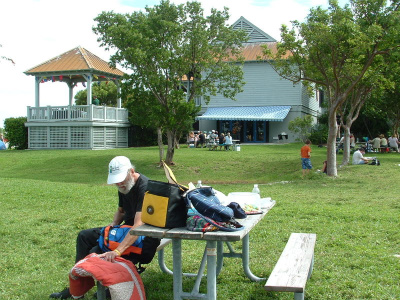 |
Visitors at Biscayne National Park sit outside on the picnic tables and listen to Grant Livingston’s concert (Photo by Jannet Jureidini). |
“We tagged some sharks, pretend ones,” his daughter Karis Knoll said eagerly. “We saw what they do with the sponges too.”
A small outdoor stage creates an intimate setting, and singer Grant Livingston performs for the crowd in honor of the park’s anniversary.
Livingston is a local musician who has spent a lot of his time in South Miami-Dade. The theme of South Florida and his appreciation for it is frequent throughout his music.
Many of his songs had a care-free and upbeat resonance, like his song about his friend Jack. The song’s simplistic tone captured the sense of freedom and open space within the park that cannot be found in the more developed areas of South Florida, which are clouded by buildings and paved streets.
“You don’t bother Jack when he’s eating pie,” Livingston sang.
However, some songs had a more somber tone, such as the song he wrote about his friend Patty whose home was lost in a hurricane.
Logically, many of his songs also focused on the theme at hand, Biscayne National Park. Livingston said he’s been performing at the park for many years. He grew up in Miami with Gary Bremen, who is now a park ranger at Biscayne.
As Livingston introduced his song about Homestead, he mentioned that Miami-Dade County is the only county in the United States that contains at least two national parks, referring to the Everglades National Park and Biscayne National Park.
“Naturally the thing you want to do is build an international airport between them,” Livingston said in a joking manner.
He sang:
You know we call Homestead home
You know we love Homestead
Meet me down in Krome
The county once actually wanted to build an international airport in Homestead, which would not be appealing for the parks’ preservation. In the song, he mentioned the impact the airport would have in simple terms. And then he sang:
We got the Everglades
We got Biscayne Bay
We don’t need no airport no way
| Visitors listen to Grant Livingston’s concert at Biscayne National Park, on the park’s 40th anniversary (Photo by Jannet Jureidini). | 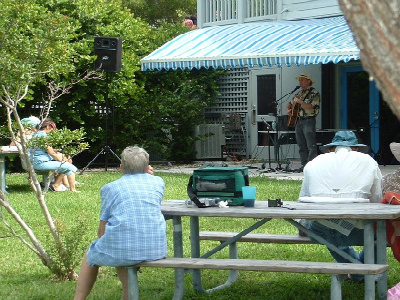 |
Luckily, the Homestead international airport never happened. Plans to build the airport on what was previously the Homestead Air Reserve Base in order to make the Miami International airport less congested were abandoned. In 2001, President Clinton and the U.S. Air Force rejected the proposal because it would disrupt the parks’ wildlife and risked pollution of the parks’ waters with jet fuel.
Livingston wanted to be a part of the Biscayne National Park’s birthday celebration because he too shared in the appreciation for the park’s many wonders.
“I write a lot of music about the environment, it kind of fits in with what the parks trying to do, preserve,” Livingston said.
A fan of Livingston’s performance, Maureen Horowitz from North Miami, came out to the park because she read an article in The Miami Herald that said the park was celebrating its 40th anniversary. After the concert she made her way to Livingston’s table of CDs.
“He’s a wonderful musician and that’s why I’m buying a CD,” Horowitz said.
She wanted to send the CD to her granddaughters, who grew up in Florida but now live in California. She wanted them to appreciate where they grew up. Part of the reason she was drawn to Livingston’s music is that its subject matter is centered on Florida.
“I think it’s really important for people to think about the place they live in and what makes it different from every other place,” Horowitz said. “They all can maybe get together to help protect it.”
Florida is a very special place to Horowitz, not only because of its tropical environment, but because she said it is the only continental state that has a coral reef within its boundaries. She emphasized how crucial it is that citizens realize the importance of looking after our natural resources and our land.
“If the development had gone in here it would have created contamination, pollution, and probably killed the reef in North Key Largo and everywhere around it,” Horowitz said. “By protecting this land, we’ve actually saved the reefs.”
She felt that if people don’t understand the biology behind why it is important to protect the “critters”, the mangrove trees, and how it all connects, it’s no wonder people aren’t alarmed when their environment is attacked. For instance, if the mangrove trees are destroyed so are the fish nurseries they contain and so on.
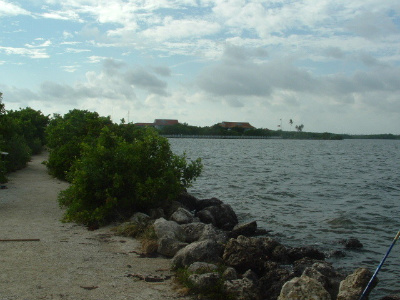 |
The view from the boardwalk and trail along the mangrove trees that extends from the Dante Fascell Visitor Center several hundred yards into the bay (Photo by Jannet Jureidini). |
This wasn’t Horowitz first visit to the park. She knows one of the men who were an integral part in protecting it from commercial development.
“I know the man Lloyd Miller, who is a citizen who organized the people to protect this land from development,” she said. “Without him this would be just condos exclusive to those people who could buy condos instead of everybody.”
She described Miller as an “ordinary citizen” whose passion for the environment led him to Washington to make a difference.
“They were actually going to build a gigantic oil refinery here,” Horowitz said.
The area was going to be industrialized and offshore they were going to build the condos and hotels, but a handful of people including Miller, stopped it.
In the 1960s, Islandia was a city that was incorporated with these development purposes, but any hope of it expanding diminished when the laws to protect the reefs were expanded. According to the year 2000 census there were only six people and three households in the city.
Miller, the man that saved the park and Horowitz’s friend, was signing copies of his book Biscayne National Park: It Almost Wasn’t, on the heels of the park’s 40th anniversary. In the book, he tells the story about how the park came to be.
Livingston recommended Miller’s book and speaking with Miller, whom he said had a lot to do with what they were now able to celebrate, which is the conservation of the park. This is something singer Livingston feels just as strongly about, as Miller does.
| Lloyd Miller at his book signing in the Dante Fascell Visitor Center at Biscayne National Park, greeted by Maureen Horowitz (Photo by Jannet Jureidini). | 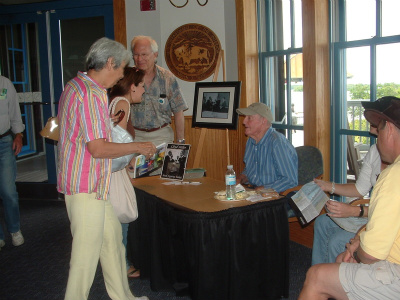 |
When Miller was asked what inspired him to be a crucial defender of Biscayne Bay’s preservation, his list was endless.
“The thought that somebody would build a deep water port, build an oil refinery, fertilizer factories, build a 300 feet wide and 30 feet deep channel across our beautiful bay and dig a hole through our coral reef — that’s a lot of inspiration,” Miller said.
It is one of three national parks and a national preserve located in South Florida; among the others are the Everglades, Dry Tortugas National Park, and the Big Cypress National Preserve. Miller said that Biscayne is the closest park to any major city in Florida.
“The fact that we were able to save this bay I think is really, very important,” he said. “If you can imagine having an oil refinery, a couple chemical factories, that close to a major metropolitan area it’s kind of scary.”
Since our prevailing winds are southeast to northwest, Miller noted, that “it would have blown all the stink over Miami.”
Miller’s personal contribution began when he started the local chapter of the Izaak Walton League of America in 1959. In 1961, Miller said his group learned of commercial and industrial development plans by one of the world’s wealthiest men, Daniel Logan, from the organization’s Washington office.
“He had bought 2,200 acres, two miles up the road here, where he was going to build this port and refinery,” Miller said. “So we set about to alert the community.”
As they spread the word, about 40 organizations joined together to try to prevent this from happening in January of 1962. Miller was asked to assemble a team in order to see if they could stop the project. They gathered information about oil refineries, oil spills, and other related disasters. They presented the information to the public and people started to take notice. Eventually, area politicians did, too.
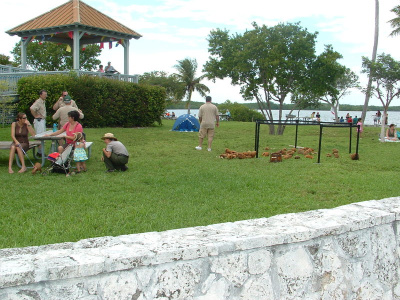 |
A Biscayne National Park interpreter talks with a child and her family in the picnic area near the Visitor Center (Photo by Jannet Jureidini). |
“There was an awful lot of politicians and big money people who wanted the oil refinery in the port and the fact that we don’t have it today is still to me a miracle,” Miller said. “How we were lucky enough to save it I have no idea, really.”
As more people and state officials became involved, the federal government finally got interested. Politicians finally recognized that it was something worth supporting, instead of opposing.
“We had a wonderful U.S. Secretary of Interior at that time. His name was Stewart Udall, one of the greatest environmentalists that the nation’s ever produced,” Miller said. “He decided that we were going to have a Biscayne National Monument 40 years ago, and it became Biscayne National Park 12 years later.”
Miller stressed the importance of taking action and getting involved as he did, to produce change by standing up for what you feel is right and not just standing by.
“It’s one of those grass roots things that’s really good for the soul and it’s something that all young folks should learn, that you got to be involved,” he said.
He pointed out that having no clean air and water, no trees, and no fish is not an alternative and that adding more development over our natural areas is not a smart choice.
Much like the message in Livingston’s song about Homestead not needing an international airport that would destroy two national parks, Miller’s advocacy for conserving Biscayne Bay, is just a small part of the bigger picture of preserving our world.
“Concrete over everything is not an option,” Miller said. “We’re not going to make anymore worlds, there’s only this one and there isn’t much of it left that’s natural.”
Generations to come can experience the beauty of Biscayne Bay, thanks to a handful of people. Preserving our one world is the very purpose Miller fought for and Livingston sang for. Without people like them Biscayne National Park wouldn’t be celebrating its 40th anniversary.
If You Go
- Address: 9700 SW 328th St., Homestead, Fla. 33033
- Hours: Dante Fascell Visitor Center – daily 9 a.m. to 5 p.m.
- Directions from the North through the Florida Turnpike: Merge onto Florida’s Turnpike South (FL-821 South). Take the SW 288th Street/Biscayne Drive exit, Exit 5 (follow signs for Biscayne National Park). Turn left onto SW 288th Street (Biscayne Drive), later turn right onto SW 137th Avenue (Speedway Boulevard).Turn left onto SW 328th Street (North Canal Drive). Follow the road for a few miles, and the entrance will be on your left.
- Parking: The Dante Fascell Visitor Center is located on Convoy Point, with free parking available in front of the visitor center. The other islands are only accessible by boat.
- Food: There is a gift shop that has food and drinks available for purchase, but the selection is very small in a refrigerator. The best option for visitors is to bring their own food.
- Tours and Facilities: Canoe and kayak rentals, as well as guided tours are available from the park’s concessionaire at Convoy Point. Call 305-230-1100 for more tour information.
- For more information on the park and its schedules visit: http://www.nps.gov/bisc/

Comments are Closed